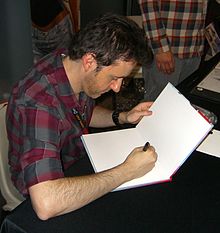J. Scott Campbell
| J. Scott Campbell | |
|---|---|
Danger Girl |
Jeffery Scott Campbell (born April 12, 1973) is an American
Early life
Jeffery Scott Campbell was born in
As a child, Campbell was interested in cartoons, rather than comics. He first became interested in comics when, as a teenager, he visited a friend's house, where his friend showed him
In 1989, Campbell, then age fifteen, entered for and won an "Invent the Ultimate Video Game" contest featured in the issue 6 of Nintendo's official magazine, Nintendo Power, whereby submitted contest entries were to consist of drawings and concepts for a video game. Color drawings from "Lockarm," the videogame idea he pitched, were published in the magazine as the winning entry.[5]
Career
Wildstorm / DC Comics

After graduating from high school in
Campbell went on to co-create the teen superhero team
In 1998, Campbell, together with fellow comics artists
The
In August 2005, Campbell published Wildsiderz, which he co-created with his Danger Girl writing partner Andy Hartnell.
In February 2006, the 200th issue of Nintendo Power included a poster featuring prominent Nintendo characters drawn by Campbell in his unique art style, along with an interview whereby Campbell recalled his memories of the "Invent the Ultimate Video Game" Contest.[dead link][7]
That same year, Campbell provided a variant incentive cover for Justice League of America (vol. 2) #0, the first issue of Brad Meltzer's run on the title.
In 2007, Campbell illustrated the covers to the Freddy vs. Jason vs. Ash six-issue limited series.
Marvel Comics

At the WizardWorld 2006 Comic Convention held in Los Angeles, Marvel Comics announced that Campbell signed an exclusive contract with the company, and to work on a Spider-Man series with writer Jeph Loeb.[8] Between 2001 and 2013 Campbell did numerous covers for The Amazing Spider-Man, including issues 30 - 35 in 2001, 50 - 52 and 500 in 2003, and seven issues done sporadically from issues 601 in 2009 and 700 in 2013. His cover to issue #30 was used as the cover of the 2003 trade paperback that collected issues 30 and 31.
In October 2016, Marvel Comics and New York-based retailer
Technique and materials

Campbell does his pencil with a
References
- ^ Chiu, Bobby (January 18, 2011). "J. Scott Campbell Interview 02 of 06". Bobby Chiu/YouTube. Retrieved September 24, 2019.
- ^ a b c d e Wizard #41 (January 1995). pp 125 - 126.
- ^ Cooke, Jon B. "The Art of Arthur Adams". Reprinted from Comic Book Artist #17, November 15, 2001
- CBR.com. Archived from the originalon March 14, 2020.
- ^ "Jeffery Scott Campbell Unlocks His Imagination". Nintendo Power. Vol. 1, no. 6. 1989. p. 95.
- Wildstorm Productions. pp. 11, 17, 19, 26 and 30.
- ^ "Go Behind the Scenes with Comic Genius and Nintendo Super Fan J. Scott Campbell". Nintendo Power. Archived from the original on September 30, 2007. Retrieved 2010-01-24.
- ^ "J. Scott Campbell signs exclusive with Marvel". Newsarama. 2006-03-17. Archived from the original on July 2, 2016. Retrieved January 24, 2010.
- CBR.com. Retrieved September 23, 2019.
- The Mary Sue. Retrieved September 23, 2019.
- ^ Flood, Alison (October 21, 2016). "Marvel pulls Iron Man cover after accusations of 'sexualising' teenage girl". The Guardian. Retrieved October 21, 2016.
- ^ a b c Campbell, J. Scott (March 4, 2008). "Pencils". DeviantArt. Archived from the original on April 27, 2019. Retrieved September 23, 2019.
- ^ Campbell, J. Scott (September 15, 2015). "Untitled". Twitter. Archived from the original on September 24, 2019. Retrieved September 23, 2019.
- ^ Campbell, J. Scott (March 4, 2008). "Drawing Supplies Erasers". DeviantArt. Archived from the original on April 27, 2019. Retrieved September 23, 2019.
External links
- Official website
- J. Scott Campbell at the Comic Book DB (archived from the original)
- J. Scott Campbell on deviantART
- J. Scott Campbell Image Gallery at Comic Art Community
- Video of Campbell speaking at the 2009 New York Comic Con (Time Stamp: 4:53)
